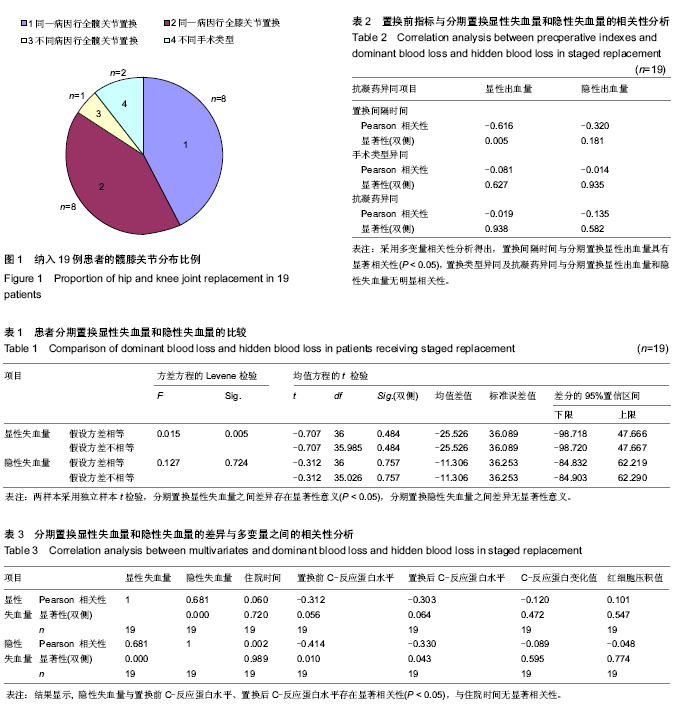| [1] Foss NB, Kehlet H. Hidden blood loss after surgery for hip fracture.J Bone Joint Surg. 2006;88(8): 1053-1059.
[2] Pattison E,Protheroe K,Pringle RM,et al. Reduction in haemoglobin after knee joint surgery. Ann Rheum Dis. 1973; 32(6):582.
[3] Sehat KR, Evans RL, Newman JH. Hidden blood loss following hip and knee arthroplasty correct management of blood loss should take hidden loss into account. J Bone Joint Surg. 2004;86(4): 561-565.
[4] Liu X, Zhang X, Chen Y, et al. Hidden blood loss after total hip arthroplasty. J Arthroplasty. 2011;26(7): 1100-1105.
[5] 张波,庞清江,章海均,等.全膝关节置换术后隐性失血的研究进展[J].中国骨伤, 2012,28(9):788-792.
[6] Tai TW,Chang CW,Yang CY,et al. Effects of tourniquet use on blood loss and soft-tissue damage in total knee arthroplasty: a randomized controlled trial. J Bone Joint Surg Am. 2012; 94(24):2209-2215.
[7] 郑杰,高迪,贾斌,等.老年全髋置换患者术后隐性出血与生存质量关系的对照研究[J].中国中医急症, 2013, 22(7):1135-1136.
[8] 陈虎,曹力,杨德盛,等.麻醉方式与全膝关节置换术后深静脉血栓发生率分析[J].中国矫形外科杂志,2012,20(5):402-405.
[9] 吴川,王秀丽.髂筋膜间隙阻滞在老年股骨粗隆间骨折麻醉中的应用[J].实用医学杂志,2012,28(20):3416-3417.
[10] 高玉镭,王东辰,李佩佳,等.人工全髋关节置换术隐性失血量的估算及原因分析[J].实用医药杂志,2012,29(6):490-492.
[11] Jiang X,Hand AR, Shen S, et al. Enhanced tissue plasminogen activator synthesis by the sympathetic neurons that innervate aging vessels. J Neurosci Res. 2003;71(4): 567-574.
[12] 刘志刚,张上上,陈如见,等.全髋关节置换后的隐性失血[J].中国组织工程研究,2013,17(13):2305-2312.
[13] Prasad N,Padmanabhan V,Mullaji A. Blood loss in total knee arthroplasty:an analysis of risk factors.Int Orthop. 2007; 31: 39-44.
[14] 罗涛,黄伟杰,吴伟,等.肥胖对半髋关节置换术围手术期失血的影响[J].中国矫形外科杂志, 2011,19(17):1419-1422.
[15] Bell TH, Berta D, Ralley F,et al. Factors affecting perioperative blood loss and transfusion rates in primary total joint arthroplasty: a prospective analysis of 1642 patients. Can J Surg. 2009;52(4):295-301.
[16] Yeager AM, Ruel AV, Westrich GH. Are bilateral total joint arthroplasty patients at a higher risk of developing pulmonary embolism following total hip and knee surgery? JArthroplasty. 2014; 29(5): 900-902.
[17] Niki Y, Katsuyama E, Takeda Y, et al. Comparison of Postoperative Morbidity Between Simultaneous Bilateral and Staged Bilateral Total Knee Arthroplasties: Serological Perspective and Clinical Consequences. JArthroplasty. 2014; 29(3): 504-509.
[18] Lindberg-Larsen M, Joergensen CC, Husted H, et al. Simultaneous and staged bilateral total hip arthroplasty: a Danish nationwide study. Arch Orthop Trauma Surg. 2013 ; 133(11): 1601-1605.
[19] Ishii Y, Noguchi H, Takeda M, et al. Length of hospital stay with patient-dependent determination in bilateral scheduled staged total knee arthroplasty. Eur J Orthop Surg Traumatol. 2014;24(6):961-965.
[20] Bini SA, Khatod M, Inacio M, et al. Same-Day Versus Staged Bilateral Total Knee Arthroplasty Poses No Increase in Complications in 6672 Primary Procedures. J Arthroplasty. 2014;29(4): 694-697.
[21] Alosh H, Shah RP, Courtney PM, et al. One-Week Staged Bilateral Total Knee Arthroplasty Protocol: A Safety Comparison of Intended and Completed Surgeries. J Arthroplasty. 2014;29(6): 1176-1180.
[22] 朱斌杰,陈哲峰,刘锋,等.同期和分期全膝关节置换术治疗双膝关节骨关节炎的安全性与疗效[J].中华骨科杂志,2014,34(6): 619-623.
[23] 周一新.骨科标准新突破手术技术指导规范-《人工髋、膝关节置换术》解读[J].中国卫生标准管理,2011,2(4): 72-74.
[24] Guan M, Wang J, Zhao L, et al. Management of hip involvement in ankylosing spondylitis. Clin Rheumatol. 2013;32(8): 1115-1120.
[25] Ward CF, Meathe EA, Benumof JL, et al. A computer nomogram for blood loss replacement. Anesthesiology. 1980;53: 126-130.
[26] Gross JB. Estimating allowable blood loss: corrected for dilution. Anesthesiology. 1983;3: 277-280.
[27] Nadler SB,Hidalgo JU,Bloch T. Prediction of blood volume in normal human adults. Surgery. 1962;57: 224-232.
[28] Erskine JG, Fraser C, Simpson R, et al. Blood loss with knee joint replacement. J R Coll Surg Edinb. 1981;26(5): 295-297.
[29] McManus KT, Velchik MG, Alavi A, et al. Non-invasive assessment of postoperative bleeding in TKA patients with Tc-99m RNCs. J Nuclear Med. 1987;28(8): 565-567.
[30] Faris PM,Ritter MA,Keating EM,et al. Unwashed filtered shed blood collected after knee and hip arthroplasties. J Bone Joint Surg. 1991;73:1169-1178
[31] Bao N, Zhou L,Cong Y,et al. Free fatty acids are responsible for the hidden blood loss in total hip and knee arthroplasty. Med Hypotheses. 2013;133(1)104-107.
[32] Prasad N,Padmanabhan V,Mullaji A.Blood Loss in Total Knee Arthroplasty:an analysis of risk factors. Int Orthop. 2007; 31(1):3944.
[33] Bertz A, Indrekvam K, Ahmed M, et al. Validity and reliability of preoperative templating in total hip arthroplasty using a digital templating system. Skeletal Radiol. 2012.
[34] Delavenne X, Frappé P, Zufferey P, et al. PK evaluation of fondaparinux sodium for the treatment of thrombosis. Expert Opin Drug Metab Toxicol. 2014;10(2): 269-277.
[35] Gómez-Outes A, Terleira-Fernández AI, Suárez-Gea ML,等. 达比加群酯,利伐沙班或阿哌沙班与依诺肝素用于全髋关节或膝关节置换术后的血栓预防:系统综述,荟萃分析和间接治疗比较[J].中华关节外科杂志(电子版),2013,7(6):96-102.
[36] 孙伟,史冬泉,庞勇,等.全髋关节置换术后速碧林或拜瑞妥抗凝治疗对隐性失血量的影响[J].中国骨与关节损伤杂志,2013, 28(2): 136-137.
[37] Alosh H, Shah RP, Courtney PM, et al. One-Week Staged Bilateral Total Knee Arthroplasty Protocol: A Safety Comparison of Intended and Completed Surgeries. J Arthroplasty. 2014;29(6): 1176-1180.
[38] Bini SA, Khatod M, Inacio M, et al. Same-Day Versus Staged Bilateral Total Knee Arthroplasty Poses No Increase in Complications in 6672 Primary Procedures. J Arthroplasty. 2014;29(4): 694-697.
[39] Fu D, Li G, Chen K, et al. Comparison of clinical outcome between simultaneous-bilateral and staged-bilateral total knee arthroplasty: a systematic review of retrospective studies. J Arthroplasty. 2013;28(7): 1141-1147.
[40] Rahman WA, Garbuz DS, Masri BA. Total hip arthroplasty in steroid-induced osteonecrosis: early functional and radiological outcomes. Can J Surg. 2013;56(1): 41.
[41] Scherer MA,Neumaier M,Von Gumppenberg S. C-reactive protein in patients who had operative fracture treatment. Clin Orthop. 2001;393:287-293.
[42] Miyamae Y, Inaba Y, Kobayashi N, et al. Different diagnostic properties of C-reactive protein, real-time PCR, and histopathology of frozen and permanent sections in diagnosis of periprosthetic joint infection. Acta Orthopaedica. 2013; 84(6): 524-529.
[43] Thienpont E, Grosu I, Jonckheere S, et al. C-reactive protein (CRP) in different types of minimally invasive knee arthroplasty. Knee Surg Sports Traumatol Arthrosc. 2013;21(11):2603-2610. doi: 10.1007/s00167-012-2345-3.
[44] Laiho K, Mäenpää H, Kautiainen H, et al. Rise in serum C reactive protein after hip and knee arthroplasties in patients with rheumatoid arthritis. Ann Rheum Dis. 2001;60(3): 275-277.
[45] Milone MT, Kamath AF, Israelite CL. Converting between high-and low-sensitivity C-reactive protein in the assessment of periprosthetic joint infection. J Arthroplasty. 2014;29(4): 685-689.
[46] Battistelli S, Fortina M, Carta S, et al. Serum C-Reactive Protein and Procalcitonin Kinetics in Patients Undergoing Elective Total Hip Arthroplasty. Bio Med Res Int. 2014. |
